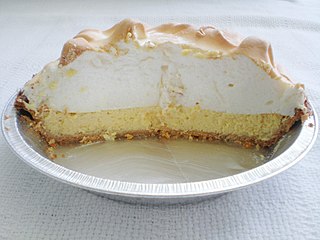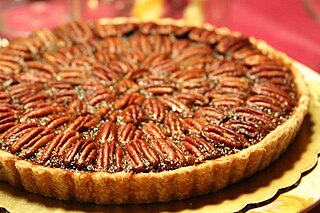
Pastry is baked food made with a dough of flour, water, and shortening that may be savoury or sweetened. Sweetened pastries are often described as bakers' confectionery. The word "pastries" suggests many kinds of baked products made from ingredients such as flour, sugar, milk, butter, shortening, baking powder, and eggs. Small tarts and other sweet baked products are called pastries as a synecdoche. Common pastry dishes include pies, tarts, quiches, croissants, and pasties.

A pie is a baked dish which is usually made of a pastry dough casing that contains a filling of various sweet or savoury ingredients. Sweet pies may be filled with fruit, nuts, fruit preserves, brown sugar, sweetened vegetables, or with thicker fillings based on eggs and dairy. Savoury pies may be filled with meat, eggs and cheese or a mixture of meat and vegetables.

An apple pie is a pie in which the principal filling is apples. Apple pie is often served with whipped cream, ice cream, custard or cheddar cheese. It is generally double-crusted, with pastry both above and below the filling; the upper crust may be solid or latticed. The bottom crust may be baked separately ("blind") to prevent it from getting soggy. Deep-dish apple pie often has a top crust only. Tarte Tatin is baked with the crust on top, but served with it on the bottom.

Cheesecake is a dessert made with a soft fresh cheese, eggs, and sugar. It may have a crust or base made from crushed cookies, graham crackers, pastry, or sometimes sponge cake. Cheesecake may be baked or unbaked, and is usually refrigerated.

Key lime pie is an American dessert pie. It is made of lime juice, egg yolks, and sweetened condensed milk. It may be served with no topping, or with a meringue topping made from egg whites, or with whipped cream. It may be cooked in a pie crust, graham cracker crust, or no crust. The dish is named after the small Key limes, which are more aromatic than the common Persian limes, and which have yellow juice. The filling in a Key lime pie is typically yellow because of the egg yolks.

Rice pudding is a dish made from rice mixed with water or milk and commonly other ingredients such as sweeteners, spices, flavourings and sometimes eggs.

Lemon ice box pie is an icebox pie consisting of lemon juice, eggs, and condensed milk in a pie crust, frequently made of graham crackers and butter. It is a variant of key lime pie; in both, the citric acidity sets the egg yolks, with minimal baking. There are also no bake versions.

Pennsylvania Dutch cuisine is the typical and traditional fare of the Pennsylvania Dutch.

Pecan pie is a pie of pecan nuts mixed with a filling of eggs, butter and sugar. Variations may include white or brown sugar, cane syrup, sugar syrup, molasses, maple syrup, or honey. It is commonly served at holiday meals in the United States and is considered a specialty of Southern U.S. origin. Most pecan pie recipes include salt and vanilla as flavorings. Pecan pie may be served with whipped cream, vanilla ice cream or hard sauce.

A cream pie, crème pie, or creme pie is a type of pie filled with a rich custard or pudding that is made from milk, cream, sugar, wheat flour, and eggs and typically topped with whipped cream.

Fruit curd is a dessert spread and topping. It is usually made with citrus fruit, though may be made with other fruits. Curds are often used as spreads and as flavourings.

An apple dumpling is a baked or boiled pastry-wrapped apple. To prepare apple dumplings, apples are peeled, cored and sometimes quartered and placed on a portion of dough. The hole from the core may be filled with cinnamon, butter and sugar and sometimes dried fruit such as raisins, sultanas, or currants. The dough is folded over the apples and sealed. Sometimes a spiced sauce is poured over the dumplings which are then baked until tender; the sugar and butter create a sweet sauce. Apple dumplings can be served hot, cold, or room temperature for breakfast, dessert, or as a main dish.

A lemon tart is a dessert dish, a variety of tart. It has a pastry shell with a lemon flavored filling.

The poppy seed roll is a pastry consisting of a roll of sweet yeast bread with a dense, rich, bittersweet filling of poppy seed. An alternative filling is a paste of minced walnuts, or minced chestnuts.

Pumpkin pie is a dessert pie with a spiced, pumpkin-based custard filling. The pumpkin and pumpkin pie are both a symbol of harvest time, and pumpkin pie is generally eaten during the fall and early winter. In the United States and Canada it is usually prepared for Thanksgiving, Christmas, and other occasions when pumpkin is in season.

Sugar cream pie is a custard pie made with a simple filling of butter, flour, cream and sugar sprinkled with cinnamon sugar. It is considered one of the desperation pies because the custard filling is made without eggs. The dessert may also be called finger pie in reference to the filling being stirred by the cook's finger before baking, as doing so avoids breaking the crust. It is similar to chess pie.

Sponge cake is a light cake made with eggs, flour and sugar, sometimes leavened with baking powder. Some sponge cakes do not contain egg yolks, like angel food cake, but most of them do. Sponge cakes, leavened with beaten eggs, originated during the Renaissance, possibly in Spain. The sponge cake is thought to be one of the first non-yeasted cakes, and the earliest attested sponge cake recipe in English is found in a book by the English poet Gervase Markham, The English Huswife, Containing the Inward and Outward Virtues Which Ought to Be in a Complete Woman (1615). Still, the cake was much more like a cracker: thin and crispy. Sponge cakes became the cake recognised today when bakers started using beaten eggs as a rising agent in the mid-18th century. The Victorian creation of baking powder by English food manufacturer Alfred Bird in 1843 allowed the addition of butter to the traditional sponge recipe, resulting in the creation of the Victoria sponge. Cakes are available in many flavours and have many recipes as well. Sponge cakes have become snack cakes via the Twinkie.
Pie in American cuisine has roots in English cuisine and has evolved over centuries to adapt to American cultural tastes and ingredients. The creation of flaky pie crust shortened with lard is credited to American innovation.
Green tomato pie is a pie in American cuisine that can be made like other fruit pies by sprinkling sugar, flour, cinnamon and other spices or raisins over sliced tomatoes and pieces of butter, or by simply cooking the ingredients on the stovetop before baking in a pastry-lined dish.


















